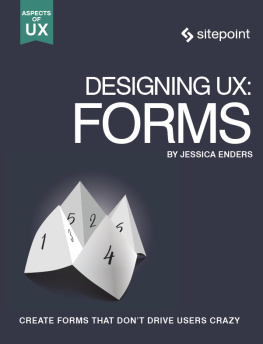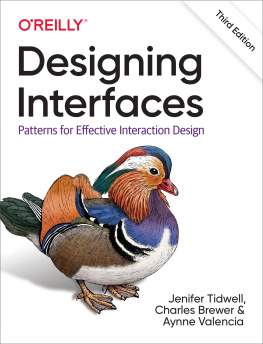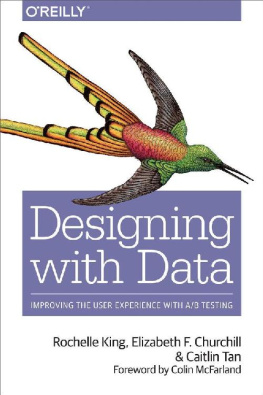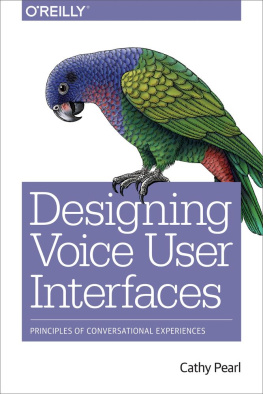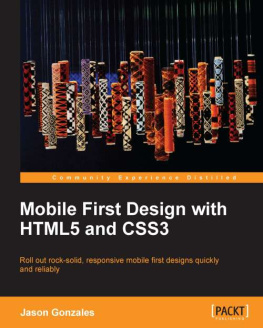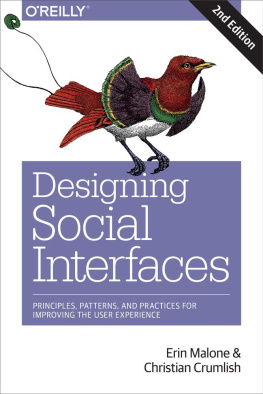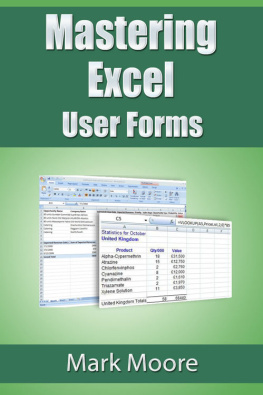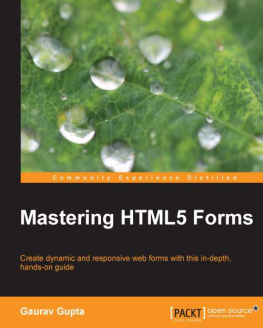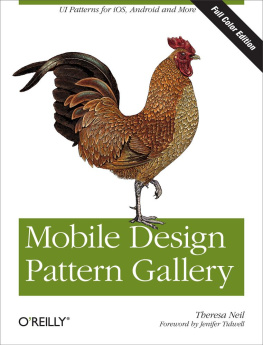Designing UX: Forms
by Jessica Enders
Copyright 2016 SitePoint Pty. Ltd.
- Managing Editor: Simon Mackie
- Series Editor: Joe Leech
- English Editor: Ralph Mason
- Technical Editor: Joe Leech
- Cover Designer: Alex Walker
- Illustrator: Natalia Balska
Notice of Rights
All rights reserved. No part of this book may be reproduced, stored in a retrieval system or transmitted in any form or by any means, without the prior written permission of the publisher, except in the case of brief quotations embodied in critical articles or reviews.
Notice of Liability
The author and publisher have made every effort to ensure the accuracy of the information herein. However, the information contained in this book is sold without warranty, either express or implied. Neither the authors and SitePoint Pty. Ltd., nor its dealers or distributors will be held liable for any damages to be caused either directly or indirectly by the instructions contained in this book, or by the software or hardware products described herein.
Trademark Notice
Rather than indicating every occurrence of a trademarked name as such, this book uses the names only in an editorial fashion and to the benefit of the trademark owner with no intention of infringement of the trademark.

Published by SitePoint Pty. Ltd.
48 Cambridge Street Collingwood
VIC Australia 3066
Web: www.sitepoint.com
Email: books@sitepoint.com
ISBN 978-0-9943470-5-3 (print)
ISBN 978-0-9953826-0-2 (ebook)
Printed and bound in the United States of America
About Jessica Enders
Jessica Enders has suffered from a lifelong condition known as a love of designing forms, applications and other transactional interfaces. She is attempting to minimize the adverse symptoms by running her own form design business, Formulate Information Design. Formulates international clients include PayPal and the Mayo Clinic; in Australia, Jessica has worked across all sectors for organizations such as Wesfarmers, Coles, Diabetes Australia, Sydney Water, Royal Melbourne Hospital, VicRoads and the Australian Prudential Regulation Authority.
Jessica has two decades of award-winning, unbeatable return-on-investment form design experience. If you have a problem with completion/conversion rates, poor data quality, low customer satisfaction or high incidence of user error, Jessica knows how to fix it. She also believes in sharing her insights with clients and community alike, writing and presenting widely. This book is her latest step toward making the world a better place, one well-designed form at a time.
About SitePoint
SitePoint specializes in publishing fun, practical, and easy-to-understand content for web professionals. Visit http://www.sitepoint.com/ to access our blogs, books, newsletters, articles, and community forums. Youll find a stack of information on JavaScript, PHP, Ruby, mobile development, design, and more.
For m.e.
You are my everything.
Table of Contents
Preface
Have you ever had a debate with your team about whether a form label should go above, inside or to the left of its field? Or whether or not to disable a button until all the required fields are filled out? Maybe a stakeholder wants to include a dumb question, and you need to help them see the light.
This book is here to help. Youll find the answers to all of the above and much more, as we look at the factors behind great form experience. Its an easy read from cover to cover, but the book is also divided into sections with clear headings that make it simple to jump to specific information.
We will concentrate on designing mobile-friendly, accessible web forms, but the focus on underlying principles means plenty is applicable to other types of formssuch as mobile and desktop apps, kiosks and even paper forms. Youll learn best practice for visual design, how to write effective questions, and what makes for a smooth flow, with some tips about managing form design projects as a bonus. So join me as we refashion forms from frustrating to fabulous.
Who Should Read This Book
This book is for designers, developers, aspiring UX professionals, and anyone with an interest in building forms that work beautifully.
Conventions Used
Look out for the following items.
Tips, Notes, and Warnings
Hey, You!
Tips provide helpful little pointers.
Ahem, Excuse Me ...
Notes are useful asides that are relatedbut not criticalto the topic at hand. Think of them as extra tidbits of information.
Make Sure You Always ...
... pay attention to these important points.
Watch Out!
Warnings highlight any gotchas that are likely to trip you up along the way.
Supplementary Materials
- https://www.sitepoint.com/community/ are SitePoints forums, for help on any tricky web problems.
- books@sitepoint.com is our email address, should you need to contact us to report a problem, or for any other reason.
Introduction
I hate telling people what I do.
Usually, the response is one of confusion: blank looks and pregnant pauses. I go on to explain, You know, like when you have to register your car or be admitted to hospital: I design the form you fill out, so its less painful. Some understanding is restored using these everyday examples. Yet people are still surprised to learn that someone actually designs these forms (a depressingly apt reflection on the quality of most).
Designing Forms Is the Worst Best Job in the World
Surprising as it may be, I love what I do. As it draws on so many different subject areas, designing forms is one of the most interesting professions you can have. Its kinda like getting paid to solve rewarding puzzles that make other peoples lives easier.
And boy are there a lot of puzzles out there that need solving. After all, when was the last time you heard someone gush with delight about a wonderful form they just filled out? Instead, every day, forms make people want to pull their hair out in frustration. And every day, organizations waste millions of dollars collecting information poorly.
But despite the huge need, and the fascinating, diverse work, form design isnt a recognized discipline. If you tell people youre an accountant, or a landscaper, or even a web developer, they have an inkling of what you do. Form design, on the other hand, is a niche within the niche of user experience.
It shouldnt be this way. The world needs more people who understand what makes one form easier to fill out than another. For some of you, reading this book will light a spark that sets you on the path to becoming a specialist form designer. For most of you, however, itll mean youre a bit more prepared to design the form thats part of a bigger web project. And while you may not be boisterously celebrated for the functional and aesthetic form you produce, know that youve made a real, tangible difference both to the people filling it out, and to your organization. Besides, at the end of the day, nothing happens without a form.
Some (Crucial) Definitions
Youd be hard pressed to find professions that ruminate about definitions more than User Experience and Design. But Im rather inclined to go against the grain, and this is meant to be a

